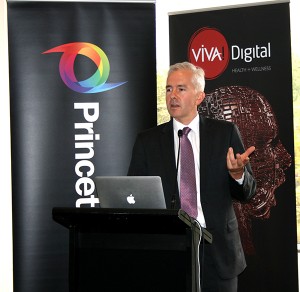Digipharma 2014 – The future of health technology
“I think the biggest innovations of the 21st century will be the intersection of biology and technology.” – Steve Jobs, co-founder and CEO of Apple Inc (1955 – 2011).
The words of the late Steve Jobs were echoed throughout the Digipharma Conference 2014, co-hosted by VIVA! Communications. Held in Sydney on Wednesday, March 27 and in Melbourne on Thursday, April 3, Digipharma saw Australian health, public relations, social media and pharma experts gather to discuss the implications of technology on the future of healthcare.
Focusing on the growth of new and emerging technologies in the health sector, The PR Warrior, Trevor Young explained how to set your brand apart using social media and online content in a noisy, digital world.
According to Trevor, in-spite of our slow uptake, Australians are among the highest users of social media in the world – we are a nation of ‘hunters and gatherers’ of information.
Trevor advised members of the healthcare and pharma industry to avoid “hip and trendy” language, as the public’s perception of health is fairly serious.
He also identified that in order to continue improving client perceptions, healthcare companies and the pharmaceutical industry need to embody transparency. According to Trevor, transparency can include:
- Revealing any flaws in your company to the public
- Using a human face in social and digital media
- Answering queries on any platform
- Providing clients with access to direct contact details, including email addresses and phone numbers
- Identifying what benefits competing companies might offer their clients.
Trevor suggested that strategy in the social space should be tailored to the patient’s needs, and not the promotion of products.
Stephen Brown, from Veeva Asia Pacific, spoke about the paradigm shift that has occurred in recent years surrounding willingness, technology and necessity.
Face-to-face sales and similar methods that have proven strong in the past, are no longer the most direct, or appropriate way to work with clients. New technology is a driver for change, allowing a new form of 24-hour interaction with the customer.
A busy client, such as a doctor or specialist, can access their emails using a smartphone or their iPad at any time of the day or night, but they can’t always stop for a 20-minute sales conversation.
“If your customer only has two minutes to speak with you, don’t aim for a 10-minute presentation via your iPad, just follow up with an email,” Stephen said.
Director of Compliance at Medicines Australia, Deborah Monk, explained the rules for mobile apps and new technologies are essentially the same under the Code’s guidelines as print media.
Other speakers delivered case studies, explained how technology is shifting with smartphones, tablets and brand new technologies including wearables such as the Moto 360 watch and Google Glass.
Many other wearable technologies are changing the way we access the Internet, the way we communicate and the way we interact with GPs and specialists.
The frequent use of apps and mobile technology by medical practitioners and specialists was identified by speakers as a key identifier of the role that new technologies play when it comes to healthcare today.
According to Dr James Freeman, Founder of GP2U telehealth, an app should be designed to make quality healthcare more accessible to everyone through technology, and by the end of 2014, 50 per cent of all internet access will occur from mobile devices.
Brett Nelson-Bond, Digital Business Unit Manager, Princeton Digital revealed 96 per cent of GP’s and 89 per cent of specialists utilise apps at work, according to the 2014 Mobile Medics Survey.
The survey also found more than 70 per cent of GP’s cite using an app during patient consultations, with 25 per cent stating they use apps to assist in practicing medicine on a daily basis.
Apps are easily accessible from any device, at any time. If the right information is easily available and provided to doctors, data shows they are likely to utilise the technology.
Digipharma 2014 identified how the world of pharma, medicine and healthcare has changed, and looked towards the future to understand how new technologies will continue to improve our health and wellbeing.

